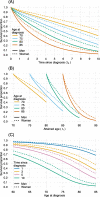Modelling multiple time-scales with flexible parametric survival models
- PMID: 36352351
- PMCID: PMC9644623
- DOI: 10.1186/s12874-022-01773-9
Modelling multiple time-scales with flexible parametric survival models
Abstract
Background: There are situations when we need to model multiple time-scales in survival analysis. A usual approach in this setting would involve fitting Cox or Poisson models to a time-split dataset. However, this leads to large datasets and can be computationally intensive when model fitting, especially if interest lies in displaying how the estimated hazard rate or survival change along multiple time-scales continuously.
Methods: We propose to use flexible parametric survival models on the log hazard scale as an alternative method when modelling data with multiple time-scales. By choosing one of the time-scales as reference, and rewriting other time-scales as a function of this reference time-scale, users can avoid time-splitting of the data.
Result: Through case-studies we demonstrate the usefulness of this method and provide examples of graphical representations of estimated hazard rates and survival proportions. The model gives nearly identical results to using a Poisson model, without requiring time-splitting.
Conclusion: Flexible parametric survival models are a powerful tool for modelling multiple time-scales. This method does not require splitting the data into small time-intervals, and therefore saves time, helps avoid technological limitations and reduces room for error.
Keywords: Cohort studies; Epidemiological methods; Flexible parametric survival models; Matched cohort; Multiple time-scales; Time-varying covariate.
© 2022. The Author(s).
Conflict of interest statement
NB and RS are employed by SDS Life Science and their time within this project was funded by SDS Life Science, however, SDS Life Science had no involvement in the study. TA, HB, PCL, PD, ARL, MH declare that they have no conflict of interest.
Figures






References
-
- Efron B. Logistic Regression, Survival Analysis, and the Kaplan-Meier Curve. J Am Stat Assoc. 1988;83(402):414–425. doi: 10.2307/2288857. - DOI
-
- Cox DR. Regression Models and Life Tables. J R Stat Soc. 1972;B(34):187–202.
-
- Royston P, Altman DG. Regression Using Fractional Polynomials of Continuous Covariates: Parsimonious Parametric Modelling. J R Stat Soc Ser C (Appl Stat). 1994;43(3):429–467.
-
- Herndon JE, II, Harrell FE., Jr The restricted cubic spline hazard model. Commun Stat Theory Methods. 1990;19(2):639–663. doi: 10.1080/03610929008830224. - DOI
Publication types
MeSH terms
Grants and funding
LinkOut - more resources
Full Text Sources

